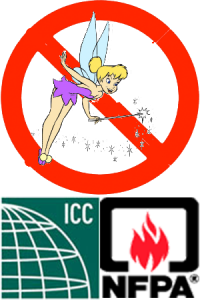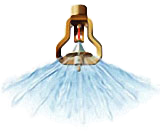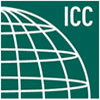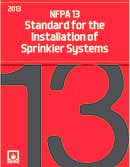 NFPA’s Fire Protection Research Foundation (FPRF) initiated a two-phase study on the effects of obstructions on the ESFR sprinkler system’s ability to suppress fires. Phase one, which was primarily a literature review on the topic, was completed in 2014 and the fire test results from the second phase are now published. The tests were performed on Group A Plastics in rack storage configurations protected by K-17 ESFR sprinklers. Read more…
NFPA’s Fire Protection Research Foundation (FPRF) initiated a two-phase study on the effects of obstructions on the ESFR sprinkler system’s ability to suppress fires. Phase one, which was primarily a literature review on the topic, was completed in 2014 and the fire test results from the second phase are now published. The tests were performed on Group A Plastics in rack storage configurations protected by K-17 ESFR sprinklers. Read more…
 In-rack sprinklers are used when ceiling sprinkler only protection is no longer adequate to protect the rack stored commodities. Well known disadvantages of current in-rack sprinkler designs are (1) additional costs and (2) additional risks of damage of the sprinkler heads during loading and unloading of the racks. Next generation in-rack sprinklers have been UL-tested that are expected to improve on conditions on both fronts. Read more…
In-rack sprinklers are used when ceiling sprinkler only protection is no longer adequate to protect the rack stored commodities. Well known disadvantages of current in-rack sprinkler designs are (1) additional costs and (2) additional risks of damage of the sprinkler heads during loading and unloading of the racks. Next generation in-rack sprinklers have been UL-tested that are expected to improve on conditions on both fronts. Read more…
 There is a better in good chance that the Globally Harmonized System (GHS) will impact your business. Current fire and building codes are based on NFPA standards, which – in some cases – differ from GHS regulations. With the start of key implementation deadlines already behind us, businesses must be aware of the differences and key requirements between these two sets of regulations in order to successfully adapt to this change. Read more…
There is a better in good chance that the Globally Harmonized System (GHS) will impact your business. Current fire and building codes are based on NFPA standards, which – in some cases – differ from GHS regulations. With the start of key implementation deadlines already behind us, businesses must be aware of the differences and key requirements between these two sets of regulations in order to successfully adapt to this change. Read more…
 According to OSHA and the U.S. Chemical Safety Board1 over the last 35 years more than 450 accidents involving dust have killed nearly 130 workers and injured more than 800. Between the years of 2008 and 2012 alone, a total of 50 combustible dust accidents2 occurred resulting in 29 fatalities and 161 injuries. Given these grim statistics, a lot of attention and effort has been spent over recent years on highlighting the risks of combustible dust, educating the public, and developing non-disruptive, cost-effective solutions that ensure life safety in the workplace Read more…
According to OSHA and the U.S. Chemical Safety Board1 over the last 35 years more than 450 accidents involving dust have killed nearly 130 workers and injured more than 800. Between the years of 2008 and 2012 alone, a total of 50 combustible dust accidents2 occurred resulting in 29 fatalities and 161 injuries. Given these grim statistics, a lot of attention and effort has been spent over recent years on highlighting the risks of combustible dust, educating the public, and developing non-disruptive, cost-effective solutions that ensure life safety in the workplace Read more…
 ESFR protection of exposed expanded Group A plastics is currently outside the scope of NFPA 13. Attempting to fill this gap, NFPA’s Fire Protection Research Foundation set out to develop experience with these types of commodities and gather data by initiating large-scale fire tests. The goal of these tests was to evaluate the necessary level of protection when ESFR sprinklers in rack storage configurations with no in-rack sprinkler protection are applied. Read more…
ESFR protection of exposed expanded Group A plastics is currently outside the scope of NFPA 13. Attempting to fill this gap, NFPA’s Fire Protection Research Foundation set out to develop experience with these types of commodities and gather data by initiating large-scale fire tests. The goal of these tests was to evaluate the necessary level of protection when ESFR sprinklers in rack storage configurations with no in-rack sprinkler protection are applied. Read more…
 The risk of asphyxiation, a condition of insufficient supply of oxygen to the body, is difficult to assess because of many factors that can contribute to an oxygen deficiency. However, these factors can be measured and used to calculate the risks that can lead to the hazardous conditions that would result in potential asphyxiation. The results can be used to make decisions about the installation, storage, and use of compressed gases as prescribed by state and local fire and building codes. Read more…
The risk of asphyxiation, a condition of insufficient supply of oxygen to the body, is difficult to assess because of many factors that can contribute to an oxygen deficiency. However, these factors can be measured and used to calculate the risks that can lead to the hazardous conditions that would result in potential asphyxiation. The results can be used to make decisions about the installation, storage, and use of compressed gases as prescribed by state and local fire and building codes. Read more…
 The International Code Council is offering free access to their I-Codes, books and Standards. Previously these documents were only available in internet (html) format. Now the International Code Council has expanded this great service of offering free access to their resources by making many of these documents available in downloadable PDF versions, that are fully searchable and have only a few limitations, such that there is no print capability. Read more…
The International Code Council is offering free access to their I-Codes, books and Standards. Previously these documents were only available in internet (html) format. Now the International Code Council has expanded this great service of offering free access to their resources by making many of these documents available in downloadable PDF versions, that are fully searchable and have only a few limitations, such that there is no print capability. Read more…
 Polyurethane foam fires are known to produce very high heat release rates and extremely toxic fumes. As a result, these types of fires provide some unique life, firefighter, property safety and fire suppression challenges. In this study polyurethane foam fires and their combustion processes are investigated using the Fire Dynamics Simulator. The software tool’s predictions were validated against test results from experimental burns. Comparisons between simulation and fire tests demonstrated unprecedented good correlation. This formed the foundation of this study validating the model and providing reliable insights into the nature and sequence of the various combustion events taking place. Read more…
Polyurethane foam fires are known to produce very high heat release rates and extremely toxic fumes. As a result, these types of fires provide some unique life, firefighter, property safety and fire suppression challenges. In this study polyurethane foam fires and their combustion processes are investigated using the Fire Dynamics Simulator. The software tool’s predictions were validated against test results from experimental burns. Comparisons between simulation and fire tests demonstrated unprecedented good correlation. This formed the foundation of this study validating the model and providing reliable insights into the nature and sequence of the various combustion events taking place. Read more…
 The 2013 Edition of NFPA 13 will be adopted by many states and jurisdictions in January 2014. In this article we will be focusing on major changes for this latest edition of NFPA 13 and specifically in the application and use of ESFR (Early Suppression, Fast Response) sprinkler systems. Read more…
The 2013 Edition of NFPA 13 will be adopted by many states and jurisdictions in January 2014. In this article we will be focusing on major changes for this latest edition of NFPA 13 and specifically in the application and use of ESFR (Early Suppression, Fast Response) sprinkler systems. Read more…
 How much do you know about fire sprinkler systems? If you are a business or a building owner, an architect, or a member of the construction industry, you may be interested in some of these commonly asked questions on sprinkler protection. Explore with us sprinkler terminology, application and use of various types of sprinkler heads, issues arising from change in occupancy or change in use, solutions to common problems, and some simple ‘rules of thumb’ Read more…
How much do you know about fire sprinkler systems? If you are a business or a building owner, an architect, or a member of the construction industry, you may be interested in some of these commonly asked questions on sprinkler protection. Explore with us sprinkler terminology, application and use of various types of sprinkler heads, issues arising from change in occupancy or change in use, solutions to common problems, and some simple ‘rules of thumb’ Read more…
 NFPA’s Fire Protection Research Foundation (FPRF) initiated a two-phase study on the effects of obstructions on the ESFR sprinkler system’s ability to suppress fires. Phase one, which was primarily a literature review on the topic, was completed in 2014 and the fire test results from the second phase are now published. The tests were performed on Group A Plastics in rack storage configurations protected by K-17 ESFR sprinklers. Read more…
NFPA’s Fire Protection Research Foundation (FPRF) initiated a two-phase study on the effects of obstructions on the ESFR sprinkler system’s ability to suppress fires. Phase one, which was primarily a literature review on the topic, was completed in 2014 and the fire test results from the second phase are now published. The tests were performed on Group A Plastics in rack storage configurations protected by K-17 ESFR sprinklers. Read more…













